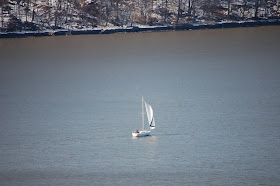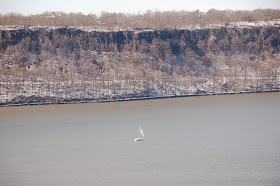gCaptain Maritime & Offshore News | AMP: Don’t Blame the Jones Act for New Jersey Salt Shortage, Blame the State!: "The Jones Act once again came under attack this week after it was unfairly blamed for a New Jersey salt shortage by state officials and the mainstream media.
The Jones Act, more formerly known as the Merchant Marine Act of 1920, requires that goods shipped between U.S. ports be transported on ships that are U.S.-owned, built and crewed. Under certain circumstances however, the U.S. Maritime Administration is allowed to grant waivers on a case-by-case basis that allows vessels not qualified under the Jones Act to transport goods between U.S. ports.
SEE ALSO: Is the Jones Act Being Blamed for Poor Planning
Now, in an attempt to set the record straight, the American Maritime Partnership, a trade association representing the U.S. domestic maritime industry, has released the following FAQ explaining what exactly did (and did not) cause New Jersey’s salt shortage."
Background:
In early February, the New Jersey Department of Transportation (“NJDOT”) announced that it had nearly run out of road salt after a brutal winter and was exploring all options to acquire additional salt. Among its options, NJDOT said, was a 40,000-ton pile of salt in Searsport, Maine. NJDOT said a foreign vessel called the Anastasia S. was standing by in Searsport to transport the salt to New Jersey. However, to use the foreign ship, NJDOT said it was requesting a waiver of the federal Jones Act, the law that requires cargo transported between points in the U.S. to move only on American vessels.
What happened with NJDOT’s waiver request?
There were two significant problems with NJDOT’s waiver request. First, NJDOT did not plan ahead and waited too long to file the waiver. A spokesman for the U.S. Department of Transportation said, “Unfortunately, by the time New Jersey reached out, U.S. DOT’s ability to help was limited, though we have identified U.S. vessels that are available to help.”
Second, the waiver request did not meet the clearly established federal criteria for a waiver — that the waiver be necessary for national defense and that no U.S. vessels be available. 46 U.S.C. 501(b) In fact, road salt is not a national defense issue and there was an identified American vessel available so NJDOT’s request failed on both counts. NJDOT has publicly conceded that federal officials told the state on Feb. 12-13 that its waiver was unlikely to qualify under federal law. Despite that, later in the day on Feb. 13 NJDOT filed the formal waiver request anyway.
Why did NJDOT file a waiver after being told that it did not meet the federal requirements?
It is not clear why NJDOT filed a waiver request that it knew would not be granted.
What about the foreign ship that was standing by in Maine ready to move the salt if the waiver had been granted?
The foreign ship is a vessel called the Anastasia S, registered under the flag of the Marshall Islands. NJDOT officials said the Anastasia S was available to move the salt. However, no one from the ship itself ever publicly confirmed that it was willing to move the salt. In fact, many vessel owners will not transport salt, a highly corrosive cargo. Transport of salt can require an extra ship cleaning that is time-consuming and expensive for the vessel owner. As such, shipping salt can be complex.
In fact, the Anastasia S was in Maine delivering another cargo for a different customer but left the area to take a previously-scheduled job shortly after NJDOT filed its waiver request. Therefore even if the waiver had been approved in record time, the ship that NJDOT planned to use was long gone. The Anastasia S left Maine early in the morning of Saturday, Feb. 15, yet media reports that the vessel was “standing by ready to move the salt” continued for days afterward.
Because the requirements for a Jones Act waiver were not present here, how else could NJDOT have transported the salt from Maine?
There simply needed be better advance planning. An American vessel was available and even on short notice is delivering the first of several loads of salt to New Jersey. With advanced planning, the salt would have gotten to New Jersey much sooner. With advanced planning, there are many other American vessels that may have been available to help transport the salt, shortening the delivery timeframe.
In a radio interview on Feb. 14, New Jersey Transportation Commissioner Jim Simpson said the foreign ship would bring the salt to New Jersey “in a day and a half” and the American vessel would have taken “a month.” Is that accurate?
Neither statement was accurate. First, as explained above, the foreign ship that Commissioner Simpson referred to left Maine shortly after the waiver was filed and was no longer available to transport the salt. Second, the American ship is delivering the first load of salt within days, not a month, and would have delivered it earlier had NJDOT simply ordered it ahead of time. In the same interview, Commissioner Simpson said “we are hoping that we get a favorable ruling today [on the waiver request]” even though he had been told the day before that the waiver was unlikely to be granted.
Are there other sources of salt besides that pile in Maine?
Of course. There are countless other sources besides the Maine salt pile, which was owned by a company called International Salt. In fact, a large shipment of salt from International Salt arrived in New Jersey from overseas on Feb. 20 and another is planned for the following week. Salt can be sourced from many domestic locations, and salt can be imported into the U.S. by ship anytime with advanced planning.
What is the major lesson from this situation?
Plan ahead and don’t delay in requesting assistance from the American maritime industry! Ironically, New Jersey is among the top states in the U.S. for American domestic vessels. With a little advanced planning, this crisis could have easily been averted.
'via Blog this'
















